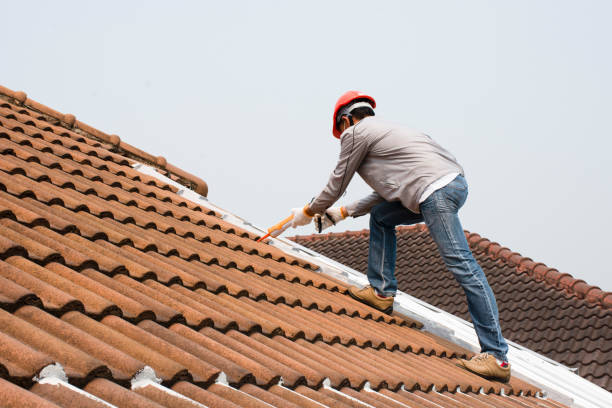Just How to Assess Different Roof Alternatives for Your Building Demands
Reviewing roof covering options for your structure requires an extensive strategy that takes into consideration numerous variables such as the meant usage of the structure, regional environment conditions, and product qualities - Roofer. It is essential to consider the benefits and disadvantages of various roof covering kinds, from asphalt tiles to steel and clay floor tiles, while likewise factoring in first prices and long-term maintenance.
Examining Your Structure's Demands
To efficiently assess roof covering options, begin by extensively examining your building's requirements. Begin by thinking about the building's meant usage, as different frameworks might require varying roof covering requirements. As an example, domestic roofings commonly prioritize aesthetic appeals and insulation, while commercial buildings may concentrate on toughness and load-bearing ability.
Next, review the local climate problems that will affect roofing performance. Elements such as temperature changes, precipitation levels, and wind patterns can affect material selection and style. A roof that excels in a pleasant environment might not execute as well in locations prone to hefty snowfall or extreme warmth.
Additionally, evaluate the architectural integrity of your building. Guarantee that the existing structure can support the selected roofing materials, especially if thinking about heavier choices. It is additionally critical to review any kind of local structure codes or regulations that may dictate certain needs for roof.

Comparing Roofing Products
As soon as a comprehensive evaluation of your structure's demands has actually been finished, the next action includes contrasting different roofing materials. Each material offers unique advantages and downsides, making it vital to straighten your choice with your details needs and conditions.
Asphalt tiles are widely acknowledged for their affordability and convenience of installment, making them a popular option for residential structures. On the other hand, metal roof, recognized for its toughness and durability, can withstand extreme climate condition but might include a higher initial financial investment.
Clay and concrete ceramic tiles offer exceptional thermal insulation and aesthetic allure, especially for Mediterranean-style style, yet they call for an even more robust architectural support because of their weight. Timber shakes deal a natural appearance and excellent insulation residential or commercial properties however might require more upkeep and are prone to fire hazards.
Examining Price and Budget
Examining your roof covering alternatives requires a cautious analysis of cost and budget factors to consider. The total budget for a roof task comprises a number of aspects, including product expenses, labor expenses, upkeep, and possible long-term savings. It is essential to establish a clear spending plan prior to checking out details roof covering materials, as this will certainly assist the decision-making process and help you avoid overspending.
Begin by obtaining quotes from numerous specialists to understand labor costs in your region. Make certain that these price quotes consist of like this all needed services, such as elimination of the old roof, setup, and any added features, like insulation or ventilation enhancements - Sylvania Roofing Contractor. Next off, examine the cost of numerous roofing products, thinking about both first setup expenses and expected life expectancy

Recognizing Energy Effectiveness
Power efficiency plays a critical duty in the choice of roof materials and systems, substantially affecting both energy consumption and total comfort within a building. A well-chosen roof covering can enhance thermal performance, reducing the demand for home heating and cooling down systems, which subsequently lowers power costs and reduces environmental influence.
When assessing roofing options, consider materials that reflect instead than take in heat. Light or reflective roofing products can considerably decrease roofing surface temperatures, resulting in lower power use throughout warm months. Additionally, appropriate insulation and air flow are vital to enhance the power efficiency of the whole roof system. this article Insulation avoids warmth transfer, while ventilation minimizes heat accumulation in the attic area.
Another essential factor is the roof's durability and upkeep needs. Sturdy materials that need much less regular replacement add to long-term energy savings. The energy performance of a roofing system can likewise be evaluated with its compliance with recognized sustainability ratings such as Power STAR or LEED.
Considering Aesthetic Charm
A roof covering's aesthetic charm substantially influences the general look of a structure, matching its architectural style view website and enhancing aesthetic allure. Roofer. When reviewing roofing choices, it is essential to take into consideration just how the chosen material, color, and design will certainly integrate with the existing framework and neighborhood. A properly designed roofing system can elevate also the easiest of buildings, changing them into visual centerpieces
Different roof materials provide various aesthetic top qualities. As an example, traditional shingles might stimulate a classic appeal, while steel roofing can give a modern, streamlined appearance. Furthermore, the color of the roof covering product plays a crucial role; lighter shades can make a building show up more roomy, while darker tones might produce a cozier setting.
Furthermore, building elements, such as dormers and eaves, can enhance the roof's aesthetic impact. It is recommended to consult with expert developers or engineers to make certain the selected roof covering alternative aligns with the general layout intent. Inevitably, a roofing ought to not only provide useful advantages yet additionally contribute favorably to the structure's aesthetic, reflecting the owner's preference and the character of the surrounding setting.
Conclusion
